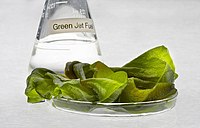
Photo from wikipedia
The demand for efficient wastewater treatment is becoming increasingly urgent due to the rising threat of pharmaceutical residues in water. As a sustainable advanced oxidation process, cold plasma technology is… Click to show full abstract
The demand for efficient wastewater treatment is becoming increasingly urgent due to the rising threat of pharmaceutical residues in water. As a sustainable advanced oxidation process, cold plasma technology is a promising approach for water treatment. However, the adoption of the technology encounters several challenges, including the low treatment efficiency and the potentially unknown environmental impact. Here, microbubble generation was integrated with cold plasma system to enhance treatment of wastewater contaminated with diclofenac (DCF). The degradation efficiency depended on the discharge voltage, gas flow, initial concentration, and pH value. The best degradation efficiency was 90.9% after 45 min plasma-bubble treatment under the optimum process parameters. The hybrid plasma-bubble system exhibited strongly synergistic performance heralded by up to seven-times higher DCF removal rates than the two systems operated separately. The plasma-bubble treatment remains effective even after addition of SO42-, Cl-, CO32-, HCO3-, and humic acid (HA) as interfering background substances. The contributions of •O2-, O3, •OH, and H2O2 reactive species to the DCF degradation process were specified. The synergistic mechanisms for DCF degradation were deduced through the analysis of the degradation intermediates. Further, the plasma-bubble treated water was proven safe and effective to stimulate seed germination and plant growth for sustainable agriculture applications. Overall, these findings provide new insights and a feasible approach with a highly synergistic removal effect for the plasma-enhanced microbubble wastewater treatment, without generating secondary contaminants.
Journal Title: Chemosphere
Year Published: 2023
Link to full text (if available)
Share on Social Media: Sign Up to like & get
recommendations!